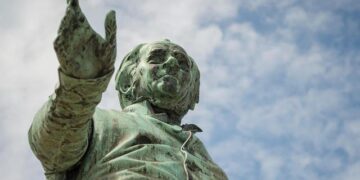ByBraden Phillips
Published October 12, 2023
• 10 min read
Intelligence, love, and beauty seemed to be the happy lot of the princess of Belgium. She had managed to avoid the loveless marriages that were often the fate of royalty: Her betrothal at age 17 to Maximilian, brother of the Austrian emperor, was as much for love as for political alliances. The young bride was wed to a man with whom she was physically and intellectually compatible. The two would travel to North America, where they became Emperor and Empress of Mexico. Born Marie-Charlotte, the new empress became better known to the world as Carlota.
Personal happiness, however, could not reckon with the turbulent geopolitics of the mid-19th century. In 1864, spurred by a lifelong quest to find a meaningful role, Carlota and her husband embarked on a catastrophic adventure to rule Mexico. The failed endeavor ended in tragedy and her husband’s death. Carlota’s mental health declined soon after, and she spent her long widowhood in seclusion.
The happy princess
Born in 1840, Carlota grew up as the favorite child of King Leopold I of Belgium. The country had only been created nine years before her birth, after it seceded from the northern Netherlands in 1831. The princess and her three brothers were the product of Leopold’s second marriage. His first had been to Charlotte, Princess of Wales, daughter of England’s future George IV. Charlotte had died in childbirth in 1817.
Leopold married Louise d’Orléans in 1832, but he never got over his first wife. More than two decades after her death, he named his infant daughter after Charlotte. The Belgian king’s links to English monarchy would become an important part of Carlota’s childhood. She spent holidays at Windsor Castle, where she was influenced by her father’s niece, Queen Victoria.
(How Queen Victoria remade the British monarchy.)
When Carlota was 10 years old, her mother died of tuberculosis. According to M.M. McAllen, author of Maximilian and Carlota: Europe’s Last Empire in Mexico, Carlota seemed to have a happy childhood despite the loss: “It hit her hard, but her father became more attentive, which helped her.” As Belgium’s first king, Leopold brought his young, well read daughter on state business to witness his famed diplomatic skills firsthand.
The frustrated archduchess
In 1856, at age 15, she met and fell in love with Archduke Maximilian. Eight years her senior, he was the younger brother of Austrian Emperor Franz Josef. Along with charm and good looks, Maximilian shared her instincts for liberalism and reform.
(Franz Josef, a ‘workaholic’ emperor was hiding a tumultuous private life.)
Maximilian’s feelings for Carlota did not, at first, seem to match hers for him. “She is very clever, which is a bit worrying, but no doubt I will get over that,” he wrote to Franz Josef, perhaps jokingly. Following the marriage, which took place just after the bride’s 17th birthday in 1857, the newlyweds sought a role for themselves. Archduchess Carlota wanted to practice her ideals about reform, while Maximilian’s lifelong plight as the “spare” to his brother’s role as heir spurred him to find a meaningful job.
Alone and widowed
Please be respectful of copyright. Unauthorized use is prohibited.
A portrait photograph of Carlota and Maximilian from circa 1864
Rude des Archives/Album
Concerned for her state of mind, Carlota’s family hid the news of Maximilian’s 1867 execution from her. She had returned to Europe in 1866 to argue for continued military support of her regime in Mexico but was turned away by France and the Vatican. Overwhelmed by the rejection, her mental health collapsed. Carlota was not told of her husband’s death until his body was returned to Belgium in 1868, six months after he died. The grief devastated her. Despite her mental illness, Carlota wrote lucidly of her feelings for Maximilian: “I find a sad satisfaction in the tributes and general admiration that surrounds his memory, but which make me cry again with each proof I find in such beautiful articles.”
An opportunity came along when Franz Josef promoted Maximilian to governor of Lombardy Venetia in what is today northern Italy. The position, however, came with some problematic strings attached: Maximilian was expected to quell the Italian nationalists rebelling against Austrian rule.
“I can feel the thorns already,” observed Carlota, “but I can also foresee the satisfaction … from doing something good.” Maximilian tried to win over the nationalists by granting them more autonomy, but Franz Josef wanted a firmer hand. When France’s Napoleon III sent in forces to support the Italians at the end of 1858, Maximilian hesitated to act militarily, which enraged his brother. He was demoted and then removed. A year later, Austria lost Lombardy but was able to retain Venice.
Royal retreat
Maximilian and Carlota sought to salve their disappointment by building a fairytale castle, Miramare, on the Adriatic Sea near Trieste. They lived onsite, and although Carlota was content for a while, planning the grounds, painting, and playing the piano, cracks began to appear in their marriage.
Rumors emerged of salacious conduct by Maximilian, including love affairs and visits to brothels. Whether Carlota knew of his affairs is uncertain, but gossip circulated that the archduke was not welcome in her bed. The pair’s inability to produce children only fueled more speculation.
International developments would present Maximilian and Carlota another opportunity to rule. Rather than Europe, their next adventure would take them across the ocean to North America. Mexico had thrown off Spanish rule in 1821, although Spain would not recognize its independence until 1836.
A move to Mexico
Political instability followed, but in 1860, liberal forces led by Benito Juárez won control of the country. Mexico’s northern neighbor, the United States, recognized Juárez’s government but was too occupied with its own civil war to provide him much support.
Europe saw Mexico as vulnerable, and France’s Napoleon III wanted it for himself. Encouraged by Mexican conservatives and Catholics, France invaded in 1862 and occupied Mexico City. To rule his new “empire,” Napoleon installed a European royal, Archduke Maximilian.
Austrian Emperor Franz Josef approved the appointment of his younger brother, but he advised Maximilian to insist on French military support and to be sure he was accepted as emperor by a majority of Mexicans. France held what many historians regard as a sham referendum that “showed” popular backing for Maximilian’s rule in Mexico.
(Life for this Bavarian princess was no fairy tale.)
The tragic empress
Carlota saw the chance to rule Mexico as a noble mission. “A monarchy is feasible,” she insisted, believing that they could provide stable leadership toMexico. Taking up residence in Chapultepec Castle outside Mexico City in 1864, the couple tried to build support by appealing to both Catholic conservatives and Juárez’s liberals. Their so-called balanced approach succeeded only in alienating both sides. Carlota played a central role, presiding over the Council of Ministers and holding public audiences on Sundays. “The empress ought to have been the man and the woman,” Maximilian wrote. “She prefers the drum, I prefer the baton.”
Political tides began to turn against the Mexican emperor and empress. After the U.S. Civil War ended, the United States began to more actively support the liberal government. In early 1866 Napoleon III withdrew French forces, abandoning Maximilian. The new Belgian king, Leopold II, Carlota’s brother, advised Maximilian to abdicate. But Carlota forbade it: “Nothing can release us from our oath.”
Desperate to save their regime, Carlota took leave of Maximilian, not knowing that she would never see him again. Back in Europe, she pleaded with Napoleon in person, but he refused to invest in the venture and recommended abdication. Hearing this, Carlota suffered a severe mental breakdown, believing that French assassins were trying to poison her. She sought the help of Pope Pius IX in Rome. During the interview with the pontiff, she attempted to spit out the “poison.”
(Napoleon lost the Battle of Waterloo—here’s what went wrong.)
Carlota’s breakdown
Perturbed by her behavior, her brother Philip, Count of Flanders, convinced her to return to Miramare. Across the Atlantic, meanwhile, Maximilian and his soldiers were captured by Mexican forces in May 1867. A month later, Maximilian was executed by a Mexican firing squad. The emperor was dead, and his short lived reign was over.
Carlota’s health deteriorated at Miramare, where she was cared for by her husband’s family. Her doctors diagnosed her with “madness with fixed ideas of persecution.” Carlota would eventually return to Belgium and her brothers, but her condition would not improve. Medicine was neither able to identify the cause of nor successfully treat her psychosis, even though she lived for another 60 years. The former empress spent much of her life in seclusion before dying in the 12th century Bouchout Castle, north of Brussels, in 1927.
Root causes?
Please be respectful of copyright. Unauthorized use is prohibited.
Teonanacatl is a mushroom whose name means “flesh of the gods” in Nahuatlted
Ted Kinsman/Age Fotostock
Carlota’s psychosis remains unexplained. Academic theories have looked at her family history, while other explanations are more creative. In 1915 a Utah newspaper claimed that tea laced with Mexican marijuana had shattered her mind. In 1987 Mexican author Fernando del Paso speculated that Carlota had consumed teonanacatl, a hallucinogenic mushroom, and gone into mental decline.
>>> Read full article>>>
Copyright for syndicated content belongs to the linked Source : National Geographic – https://www.nationalgeographic.com/premium/article/carlota-belgium-mexico-princess































